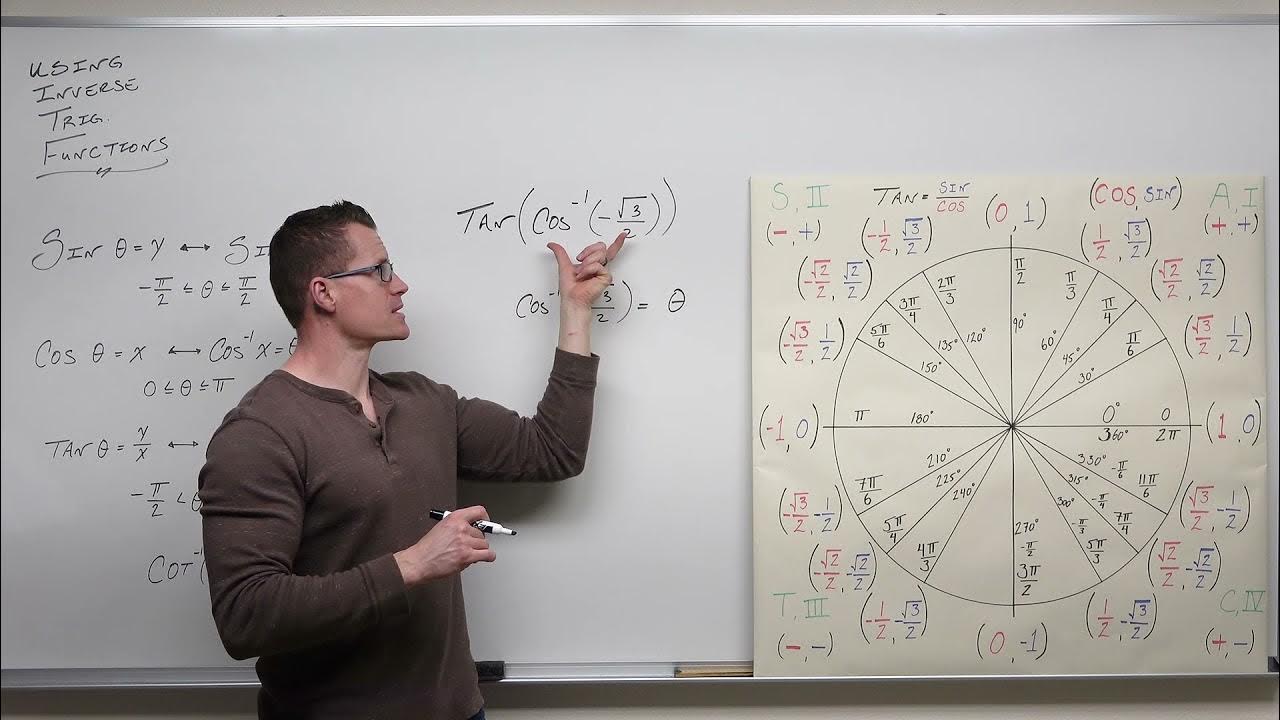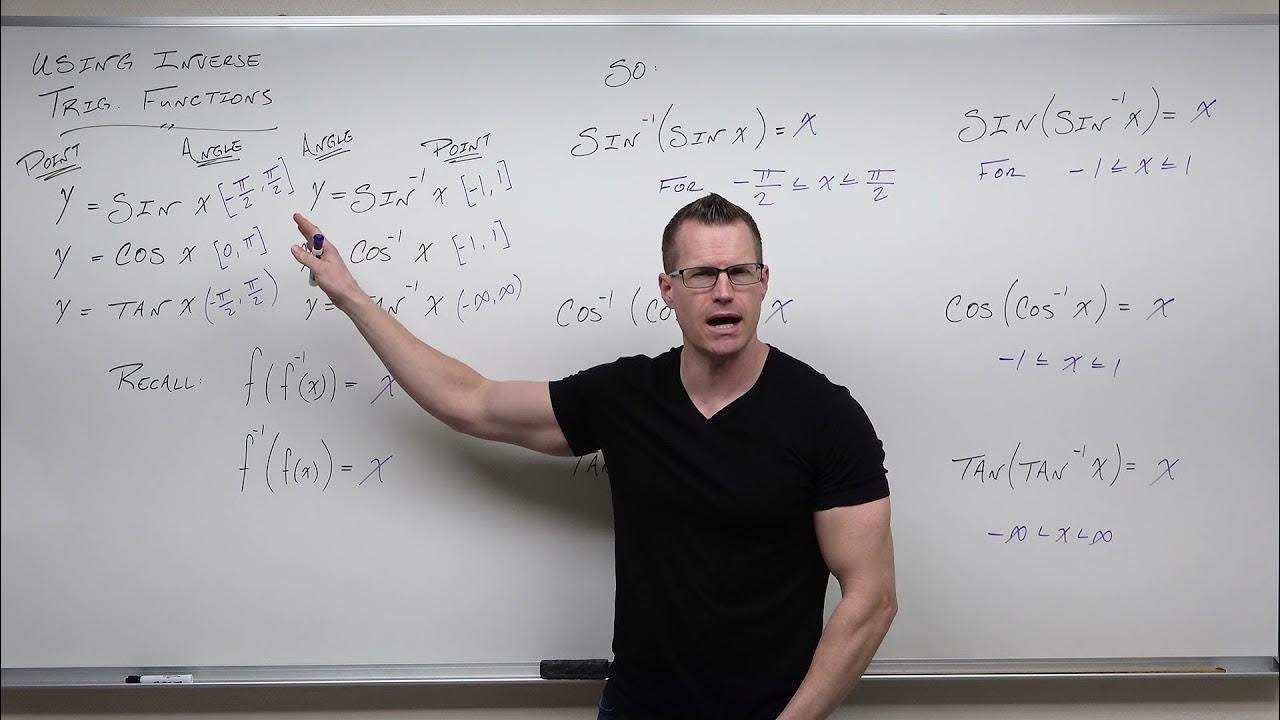Evaluating Inverse Trigonometric Functions
TLDRThe transcript discusses the evaluation of inverse trigonometric functions, focusing on arcsine, arccosine, and arctangent. It explains the range and quadrants where these functions are defined, and how to determine the correct angle for a given trigonometric value. The process involves understanding the unit circle, reference triangles, and the signs of trigonometric functions in different quadrants. The transcript also covers special cases, such as the composition of inverse trig functions and their simplification.
Takeaways
- 📐 The arc sine function has a range of -π/2 to π/2 and exists in quadrants 1 and 4, not in 2 and 3.
- 📐 The arc sine of 1/2 is π/6, not 5π/6, due to the function's range restrictions.
- 📐 For the arc sine of square root of 3 over 2, the correct angle is 60° or π/3, based on the function's domain and the reference triangle.
- 📐 The arc sine of negative values must be within the range of -π/2 to π/2, eliminating angles outside this range.
- 📐 The arc cosine function has a range of 0 to π and exists in quadrants 1 and 2, not in 3 and 4.
- 📐 The arc cosine of 1/2 is π/3 (60°), not 5π/3, due to the function's range and its positivity in quadrant 1.
- 📐 The arc cosine of negative values must be within the range of 0 to π, considering the function's domain and sign in quadrants.
- 📐 The arc tangent function has a range of -π/2 to π/2 and exists in quadrants 1 and 4, not in 2 and 3.
- 📐 The arc tangent of 1 is 45° or π/4, as the tangent of this angle equals 1 due to equal opposite and adjacent sides.
- 📐 The composition of inverse trigonometric functions can simplify to the original angle when the functions' domains overlap, such as arc sine of sine value.
Q & A
What is the value of the inverse sine of one half?
-The value of the inverse sine of one half is pi/6 or 30 degrees, because sine of pi/6 (or 30 degrees) is equal to one half.
Why is the arc sine of one half not equal to 5 pi/6?
-The arc sine of one half is not equal to 5 pi/6 because the range of the arc sine function is from -pi/2 to pi/2. 5 pi/6 falls outside of this range, hence it is not the correct answer.
In which quadrants does the arc sine function exist?
-The arc sine function exists in quadrants 1 and 4, where sine values are positive and negative respectively, within the range of -pi/2 to pi/2.
What is the value of the arc sine of the square root of three over two?
-The value of the arc sine of the square root of three over two is 60 degrees or pi/3, because sine of 60 degrees (or pi/3 radians) is equal to the square root of three over two.
How do you determine the correct quadrant for the arc sine of a negative value?
-For the arc sine of a negative value, the correct quadrant is determined by the range of the arc sine function, which is -pi/2 to pi/2. The angle must be within this range and since sine is negative in quadrant 4, the answer will be in quadrant 4.
What is the value of the inverse cosine of one half?
-The value of the inverse cosine of one half is pi/3 or 60 degrees, because cosine of pi/3 (or 60 degrees) is equal to one half.
What is the range of the arc cosine function?
-The range of the arc cosine function is from 0 to pi, as it exists in quadrants 1 and 2.
What is the value of the arc tangent of zero?
-The value of the arc tangent of zero is zero degrees, because tangent of zero degrees is equal to zero (y/x = 0/1 = 0).
What is the value of the inverse tangent of one?
-The value of the inverse tangent of one is 45 degrees or pi/4 radians, because tangent of 45 degrees (or pi/4 radians) is equal to one (y/x = 1/1 = 1).
How do you evaluate the inverse tangent of a negative value?
-To evaluate the inverse tangent of a negative value, you need to find an angle in quadrant 4 where the tangent is negative, and the range must be between -pi/2 and pi/2.
What happens when you evaluate arc sine of sine of an angle?
-When you evaluate arc sine of sine of an angle, the arc sine and sine functions cancel each other out, giving you the original angle value if it falls within the valid range of the arc sine function.
Outlines
📚 Understanding the Arcsine Function
This paragraph discusses the concept of evaluating inverse sine functions, specifically focusing on how to find the value of the arcsine of one half. It explains the relationship between the sine function and its inverse, the arcsine, and how to determine the correct angle based on the quadrant in which the function exists. The paragraph clarifies that the arcsine of one half is equal to pi/6, not 5pi/6, due to the range of the arcsine function being from -pi/2 to pi/2. It also touches on the behavior of the arcsine function in different quadrants and how to use a calculator to confirm the results.
📐 Evaluating Arcsine and Arccosine Functions
The second paragraph continues the discussion on inverse trigonometric functions, focusing on the arcsine and arccosine of specific values. It explains how to determine the correct angle for the arcsine of the square root of three over two and the arccosine of one half. The paragraph emphasizes the importance of considering the range and quadrant of these functions, which are crucial for finding the correct answers. It also provides examples of how to eliminate incorrect answers based on these criteria and concludes with a brief introduction to the evaluation of inverse cosine functions.
📌 Arctan and Inverse Trigonometric Function Composition
This paragraph delves into the evaluation of the arctangent function and the composition of inverse trigonometric functions. It explains the process of finding the arctangent of zero and one, and how to determine the correct angle for the inverse tangent of the square root of three. The paragraph also discusses the range and quadrant of the arctangent function and provides an example of how to simplify the composition of inverse functions, such as arcsine of sine pi over three, resulting in a simplified answer of pi over three.
🧮 Comprehensive Review of Inverse Trigonometric Functions
The fourth paragraph offers a comprehensive review of the inverse trigonometric functions, including arcsine, arccosine, and arctangent. It summarizes the quadrants in which each function exists and their respective ranges. The paragraph also explains how to evaluate these functions for specific values, such as zero, one, and negative one, and emphasizes the importance of considering the quadrant and range when determining the correct angle. This paragraph serves as a recap and reinforcement of the concepts discussed in the previous sections.
🔍 Advanced Evaluation Techniques
The final paragraph builds upon the previous discussions by introducing advanced evaluation techniques for inverse trigonometric functions. It provides a detailed example of how to evaluate the inverse sine of a trigonometric function, specifically arcsine of sine pi over three. The paragraph illustrates the process of simplifying the expression by canceling out the inner function, resulting in a straightforward answer of pi over three. This example demonstrates the practical application of understanding the behavior of inverse functions and their composition.
Mindmap
Keywords
💡Inverse Sine Function
💡Unit Circle
💡Range of Functions
💡Quadrants
💡Sine Function
💡Inverse Cosine Function
💡Trigonometric Functions
💡Reference Angles
💡Inverse Tangent Function
💡Trigonometric Identities
Highlights
The discussion focuses on evaluating inverse sine functions, providing insights into how to find the value of the inverse sine for given numbers.
The sine of an angle that equals one-half is key to finding the value of the inverse sine, with specific angles mentioned such as pi/six and 30 degrees.
The range of the arc sine function, which is from negative pi/two to pi/two, is crucial in determining the correct answer for the inverse sine.
The concept of reference angles is introduced, showing how they relate to finding the correct angle in the appropriate quadrant for inverse sine values.
The inverse sine function's existence only in quadrants one and four is emphasized, which affects the selection of correct answers.
The use of a calculator to confirm arc sine values is mentioned, providing a practical tool for verifying the accuracy of solutions.
Examples of finding the arc sine of the square root of three over two are given, demonstrating the process of elimination to arrive at the correct angle.
The concept of inverse cosine functions is introduced, with an explanation of how to evaluate them, particularly for the input of one-half.
The range of the arc cosine function, from zero to pi, is discussed, which is essential for determining the correct quadrant and value for inverse cosine.
The process of evaluating inverse tangent functions is detailed, including how to find the angle when given a tangent value.
The range of the inverse tangent function, from negative pi/two to pi/two, is highlighted, guiding the selection of correct answers.
The method for finding the exact value of inverse trigonometric functions is explained, with a focus on the importance of quadrants and ranges.
The composition of inverse trig functions is discussed, with an example showing how arc sine and sine can cancel each other out.
The importance of understanding the existence of inverse trig functions in specific quadrants is emphasized for accurate evaluation.
The process of eliminating incorrect answers based on quadrant and range is demonstrated for various inverse trigonometric function evaluations.
The use of reference triangles, such as the 30-60-90 triangle, is shown as a method for determining tangent values and corresponding angles.
The concept of coterminal angles is mentioned, which is relevant for finding the correct angle when dealing with inverse trig functions.
The impact of the sign of the input value on the selection of the correct quadrant for inverse trig functions is discussed.
The evaluation of inverse cosine for negative inputs is covered, showing how to find the correct angle in the second quadrant.
The evaluation of inverse tangent for both positive and negative inputs is detailed, including the use of reference angles and quadrants.
The process of rationalizing the denominator is explained in the context of evaluating inverse tangent for certain values.
The summary of the ranges and quadrants for arc cosine, arc sine, and arc tangent functions is provided for quick reference.
Transcripts
Browse More Related Video

Unit Circle Trigonometry - Sin Cos Tan - Radians & Degrees

An Indepth Look at Using Inverse Trig Functions (Precalculus - Trigonometry 21)

Take Derivatives of Inverse Trig Functions (ArcSin, ArcCos) - [2]

Derivatives of Inverse Trigonometric Functions

How to Use Inverse Trigonometric Functions (Precalculus - Trigonometry 18)

Trig - 0.7 Trig Functions of Any Angle
5.0 / 5 (0 votes)
Thanks for rating: